
Concept explainers
(a)
Interpretation:
The structural formula is required for Hydrogen peroxide (
Concept Introduction:
The structure formula is the representation of the position of its atoms present in molecules along with the bonds which are present in between the atoms of molecule. There are two model which can help to detemine the sturcture of molecule: Lewis Model and VSEPR Model- The valence-shell electron-pair repulsion model.
Answer to Problem 10.17P
Following is structure formula of Hydrogen peroxide (
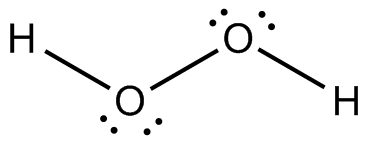
- Oxygen can form two covalent bonds and there are two unshared pair of electron present on each oxygen atom. Here both oxygen atoms are joined forming one single bond with hydrogen and two pairs are represnted with dots which is completing octet of oxygen.
- Hydrogen atom can form one covalent bond and there is no unshared pair of electron. Both hydrogen atoms are bonded with oxygen atoms and completing their octet.
Explanation of Solution
The structure of any atom is prepared with the help of Lewis model which explains guideline for bonding of atom. It guides about the covalent bonds which are formed in various combinations of single, double and triple bonds.
For several covalent bonds in organic compound containing carbon bonded to hydrogen, nitrogen, chlorine and oxygen shows some important points to be noted for structure are as follow:
- Carbon forms four covalent bonds while hydrogen form one covalent bond and both has no unshared pair of electrons.
- Three covalent bonds are formed in nitrogen atom with only one unshared pair of electron left behind.
- Oxygen can form two covalent bonds and have further more two unshared pair of electron.
- Iodine, chlorine, bromine and fluorine like halogens can form only one covalent bond like hydrogen but they have three unshared pair of electrons.
Following is structure formula of Hydrogen peroxide (
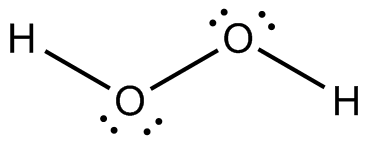
- Oxygen can form two covalent bonds and there are two unshared pair of electron present on each oxygen atom. Here both oxygen atoms are joined forming one single bond with hydrogen and two pairs are represnted with dots which is completing octet of oxygen.
- Hydrogen atom can form one covalent bond and there is no unshared pair of electron. Both hydrogen atoms are bonded with oxygen atoms and completing their octet.
(b)
Interpretation:
The structural formula is required for Hydrazine (
Concept Introduction:
The structure formula is the representation of the position of its atoms present in molecules along with the bonds which are present in between the atoms of molecule. There are two model which can help to detemine the sturcture of molecule: Lewis Model and VSEPR Model- The valence-shell electron-pair repulsion model.
Answer to Problem 10.17P
Following is structural formula for Hydrazine (
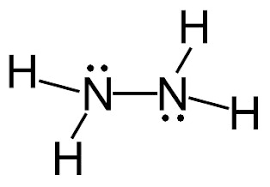
- In hydrazine, both nitrogen atoms are bonded together with single bond and have one unshared pair of electron represented as two dots on each nitrogen atom. Both nitrogen atoms has also formed single bonds with two hydrogen atoms each and completing their octet.
- All hydrogen atoms are bonded with nitrogen atoms and formed single bonds.
Explanation of Solution
The structure of any atom is prepared with the help of Lewis model which explains guideline for bonding of atom. It guides about the covalent bonds which are formed in various combinations of single, double and triple bonds.
For several covalent bonds in organic compound containing carbon bonded to hydrogen, nitrogen, chlorine and oxygen shows some important points to be noted for structure are as follow:
- Carbon forms four covalent bonds while hydrogen form one covalent bond and both has no unshared pair of electrons.
- Three covalent bonds are formed in nitrogen atom with only one unshared pair of electron left behind.
- Oxygen can form two covalent bonds and have further more two unshared pair of electron.
- Iodine, chlorine, bromine and fluorine like halogens can form only one covalent bond like hydrogen but they have three unshared pair of electrons.
Following is structural formula for Hydrazine (
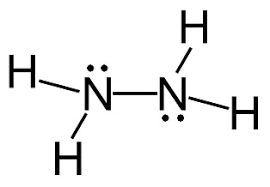
- In hydrazine, both nitrogen atoms are bonded together with single bond and have one unshared pair of electron represented as two dots on each nitrogen atom. Both nitrogen atoms has also formed single bonds with two hydrogen atoms each and completing their octet.
- All hydrogen atoms are bonded with nitrogen atoms and formed single bonds.
(c)
Interpretation:
The structural formula is required for Methanol (
Concept Introduction:
The structure formula is the representation of the position of its atoms present in molecules along with the bonds which are present in between the atoms of molecule. There are two model which can help to detemine the sturcture of molecule: Lewis Model and VSEPR Model- The valence-shell electron-pair repulsion model.
Answer to Problem 10.17P
Following is structural formula for Methanol (
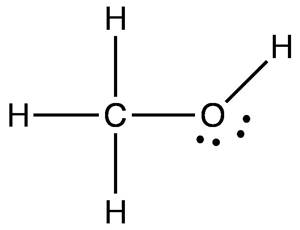
- Methanol has one oxygen atom which has two single bonds with hydrogen and carbon and two unshared pair of electrons is represented with dots over oxygen symbol.
- Three hydrogen atoms are bonded with carbon atoms and formed single bonds whereas rest hydrogen is bonded with oxygen and forming single bond.
- Carbon atom is linked with three hydrogen atoms and one oxygen atom forming total four single bonds and there is no unshared pair of electron with it.
Explanation of Solution
The structure of any atom is prepared with the help of Lewis model which explains guideline for bonding of atom. It guides about the covalent bonds which are formed in various combinations of single, double and triple bonds.
For several covalent bonds in organic compound containing carbon bonded to hydrogen, nitrogen, chlorine and oxygen shows some important points to be noted for structure are as follow:
- Carbon forms four covalent bonds while hydrogen form one covalent bond and both has no unshared pair of electrons.
- Three covalent bonds are formed in nitrogen atom with only one unshared pair of electron left behind.
- Oxygen can form two covalent bonds and have further more two unshared pair of electron.
- Iodine, chlorine, bromine and fluorine like halogens can form only one covalent bond like hydrogen but they have three unshared pair of electrons.
Following is structural formula for Methanol (

- Methanol has one oxygen atom which has two single bonds with hydrogen and carbon and two unshared pair of electrons is represented with dots over oxygen symbol.
- Three hydrogen atoms are bonded with carbon atoms and formed single bonds whereas rest hydrogen is bonded with oxygen and forming single bond.
- Carbon atom is linked with three hydrogen atoms and one oxygen atom forming total four single bonds and there is no unshared pair of electron with it.
(d)
Interpretation:
The structural formula is required for Methanethiol (
Concept Introduction:
The structure formula is the representation of the position of its atoms present in molecules along with the bonds which are present in between the atoms of molecule. There are two model which can help to detemine the sturcture of molecule: Lewis Model and VSEPR Model- The valence-shell electron-pair repulsion model.
Answer to Problem 10.17P
Following is structural formula for Methanethiol (

- In Methanethiol, carbon atom is linked with one sulphur and three hydrogen atoms forming four single bonds and completing its octet.
- One hydrogen atom has formed single bond with sulphur whereas three hydrogen atoms has formed single bonds with carbon and completed their octet.
- Sulphur has two unshared pair of electrons and two single bonds with hydrogen and carbon.
Explanation of Solution
The structure of any atom is prepared with the help of Lewis model which explains guideline for bonding of atom. It guides about the covalent bonds which are formed in various combinations of single, double and triple bonds.
For several covalent bonds in organic compound containing carbon bonded to hydrogen, nitrogen, chlorine and oxygen shows some important points to be noted for structure are as follow:
- Carbon forms four covalent bonds while hydrogen form one covalent bond and both has no unshared pair of electrons
- Three covalent bonds are formed in nitrogen atom with only one unshared pair of electron left behind.
- Oxygen can form two covalent bonds and have further more two unshared pair of electron.
Following is structural formula for Methanethiol (
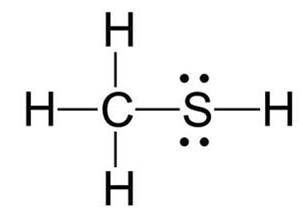
- In Methanethiol, carbon atom is linked with one sulphur and three hydrogen atoms forming four single bonds and completing its octet.
- One hydrogen atom has formed single bond with sulphur whereas three hydrogen atoms has formed single bonds with carbon and completed their octet.
- Sulphur has two unshared pair of electrons and two single bonds with hydrogen and carbon.
(e)
Interpretation:
The structural formula is required for Methylamine (
Concept Introduction:
The structure formula is the representation of the position of its atoms present in molecules along with the bonds which are present in between the atoms of molecule. There are two model which can help to detemine the sturcture of molecule: Lewis Model and VSEPR Model- The valence-shell electron-pair repulsion model.
Answer to Problem 10.17P
Following is structural formula for Methylamine (
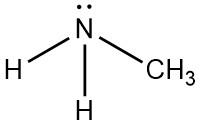
- Nitrogen atom in methylamine is linked with carbon and two hydrogen atoms through single bonds and one unshared pair of electrons is seen on symbol of atom.
- Carbon atom has one single bond with nitrogen atom and three single bonds with hydrogen atoms which results into completion of octet of carbon with no unshared pair of electron.
- Total five hydrogen atoms are present in methylamine from which two hydrogen atoms have single bonds with nitrogen atoms and three hydrogen atoms have single bond with carbon atoms and completing their octet.
Explanation of Solution
The structure of any atom is prepared with the help of Lewis model which explains guideline for bonding of atom. It guides about the covalent bonds which are formed in various combinations of single, double and triple bonds.
For several covalent bonds in organic compound containing carbon bonded to hydrogen, nitrogen, chlorine and oxygen shows some important points to be noted for structure are as follow:
- Carbon forms four covalent bonds while hydrogen form one covalent bond and both has no unshared pair of electrons.
- Three covalent bonds are formed in nitrogen atom with only one unshared pair of electron left behind.
- Oxygen can form two covalent bonds and have further more two unshared pair of electron.
- Iodine, chlorine, bromine and fluorine like halogens can form only one covalent bond like hydrogen but they have three unshared pair of electrons.
Following is structural formula for Methylamine (
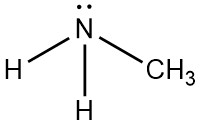
- Nitrogen atom in methylamine is linked with carbon and two hydrogen atoms through single bonds and one unshared pair of electrons is seen on symbol of atom.
- Carbon atom has one single bond with nitrogen atom and three single bonds with hydrogen atoms which results into completion of octet of carbon with no unshared pair of electron.
- Total five hydrogen atoms are present in methylamine from which two hydrogen atoms have single bonds with nitrogen atoms and three hydrogen atoms have single bond with carbon atoms and completing their octet.
(f)
Interpretation:
The structural formula is required for Chloromethane (
Concept Introduction:
The structure formula is the representation of the position of its atoms present in molecules along with the bonds which are present in between the atoms of molecule. There are two model which can help to detemine the sturcture of molecule: Lewis Model and VSEPR Model- The valence-shell electron-pair repulsion model.
Answer to Problem 10.17P
Following is structural formula for Chloromethane (
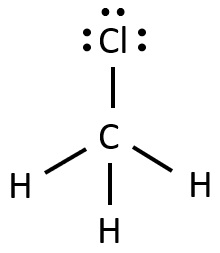
- Chloromethane has halogen atom as chlorine which is linked with carbon atom and forming single bond and has three unshared pair of electrons.
- Carbon completes its octet by forming three single bonds with three hydrogen atoms and one single bond with chlorine.
- All three hydrogen forms single-single bonds with carbon and fills their octet.
Explanation of Solution
The structure of any atom is prepared with the help of Lewis model which explains guideline for bonding of atom. It guides about the covalent bonds which are formed in various combinations of single, double and triple bonds.
For several covalent bonds in organic compound containing carbon bonded to hydrogen, nitrogen, chlorine and oxygen shows some important points to be noted for structure are as follow:
- Carbon forms four covalent bonds while hydrogen form one covalent bond and both has no unshared pair of electrons.
- Three covalent bonds are formed in nitrogen atom with only one unshared pair of electron left behind.
- Oxygen can form two covalent bonds and have further more two unshared pair of electron.
- Iodine, chlorine, bromine and fluorine like halogens can form only one covalent bond like hydrogen but they have three unshared pair of electrons.
Following is structural formula for Chloromethane (

- Chloromethane has halogen atom as chlorine which is linked with carbon atom and forming single bond and has three unshared pair of electrons.
- Carbon completes its octet by forming three single bonds with three hydrogen atoms and one single bond with chlorine.
- All three hydrogen forms single-single bonds with carbon and fills their octet.
Want to see more full solutions like this?
Chapter 10 Solutions
Introduction to General, Organic and Biochemistry
- Predict the products of this organic reaction: + H ZH NaBH3CN H+ n. ? Click and drag to start drawing a structure. Xarrow_forwardWhat is the missing reactant R in this organic reaction? + R H3O+ + • Draw the structure of R in the drawing area below. • Be sure to use wedge and dash bonds if it's necessary to draw one particular enantiomer. Click and drag to start drawing a structure.arrow_forwardWhat would be the best choices for the missing reagents 1 and 3 in this synthesis? 1 1. PPh3 2. n-BuLi 2 • Draw the missing reagents in the drawing area below. You can draw them in any arrangement you like. • Do not draw the missing reagent 2. If you draw 1 correctly, we'll know what it is. • Note: if one of your reagents needs to contain a halogen, use bromine. Click and drag to start drawing a structure.arrow_forward
- The product on the right-hand side of this reaction can be prepared from two organic reactants, under the conditions shown above and below the arrow. Draw 1 and 2 below, in any arrangement you like. 1+2 NaBH₂CN H+ N Click and drag to start drawing a structure. X $arrow_forwardExplain what is the maximum absorbance of in which caffeine absorbs?arrow_forwardExplain reasons as to why the amount of caffeine extracted from both a singular extraction (5ml Mountain Dew) and a multiple extraction (2 x 5.0ml Mountain Dew) were severely high when compared to coca-cola?arrow_forward
- Protecting Groups and Carbonyls 6) The synthesis generates allethrolone that exhibits high insect toxicity but low mammalian toxicity. They are used in pet shampoo, human lice shampoo, and industrial sprays for insects and mosquitos. Propose detailed mechanistic steps to generate the allethrolone label the different types of reagents (Grignard, acid/base protonation, acid/base deprotonation, reduction, oxidation, witting, aldol condensation, Robinson annulation, etc.) III + VI HS HS H+ CH,CH,Li III I II IV CI + P(Ph)3 V ༼ Hint: no strong base added VI S VII IX HO VIII -MgBr HgCl2,HgO HO. isomerization aqeuous solution H,SO, ༽༽༤༽༽ X MeOH Hint: enhances selectivity for reaction at the S X ☑arrow_forwardDraw the complete mechanism for the acid-catalyzed hydration of this alkene. esc 田 Explanation Check 1 888 Q A slock Add/Remove step Q F4 F5 F6 A བྲA F7 $ % 5 @ 4 2 3 & 6 87 Click and drag to start drawing a structure. © 2025 McGraw Hill LLC. All Rights Reserved. Terms of Use | Privacy Ce W E R T Y U S D LL G H IK DD 요 F8 F9 F10 F1 * ( 8 9 0 O P J K L Z X C V B N M H He commandarrow_forwardExplanation Check F1 H₂O H₂ Pd 1) MCPBA 2) H3O+ 1) Hg(OAc)2, H₂O 2) NaBH4 OH CI OH OH OH hydration halohydrin formation addition halogenation hydrogenation inhalation hydrogenation hydration ☐ halohydrin formation addition halogenation formation chelation hydrogenation halohydrin formation substitution hydration halogenation addition Ohalohydrin formation subtraction halogenation addition hydrogenation hydration F2 80 F3 σ F4 F5 F6 1 ! 2 # 3 $ 4 % 05 Q W & Å © 2025 McGraw Hill LLC. All Rights Reserved. F7 F8 ( 6 7 8 9 LU E R T Y U A F9arrow_forward
- Show the mechanism steps to obtain the lowerenergy intermediate: *see imagearrow_forwardSoap is made by the previous reaction *see image. The main difference between one soap and another soap isthe length (number of carbons) of the carboxylic acid. However, if a soap irritates your skin, they mostlikely used too much lye.Detergents have the same chemical structure as soaps except for the functional group. Detergentshave sulfate (R-SO4H) and phosphate (R-PO4H2) functional groups. Draw the above carboxylic acidcarbon chain but as the two variants of detergents. *see imagearrow_forwardWhat are the reactions or reagents used? *see imagearrow_forward
 Chemistry: The Molecular ScienceChemistryISBN:9781285199047Author:John W. Moore, Conrad L. StanitskiPublisher:Cengage Learning
Chemistry: The Molecular ScienceChemistryISBN:9781285199047Author:John W. Moore, Conrad L. StanitskiPublisher:Cengage Learning Introductory Chemistry: An Active Learning Approa...ChemistryISBN:9781305079250Author:Mark S. Cracolice, Ed PetersPublisher:Cengage Learning
Introductory Chemistry: An Active Learning Approa...ChemistryISBN:9781305079250Author:Mark S. Cracolice, Ed PetersPublisher:Cengage Learning

